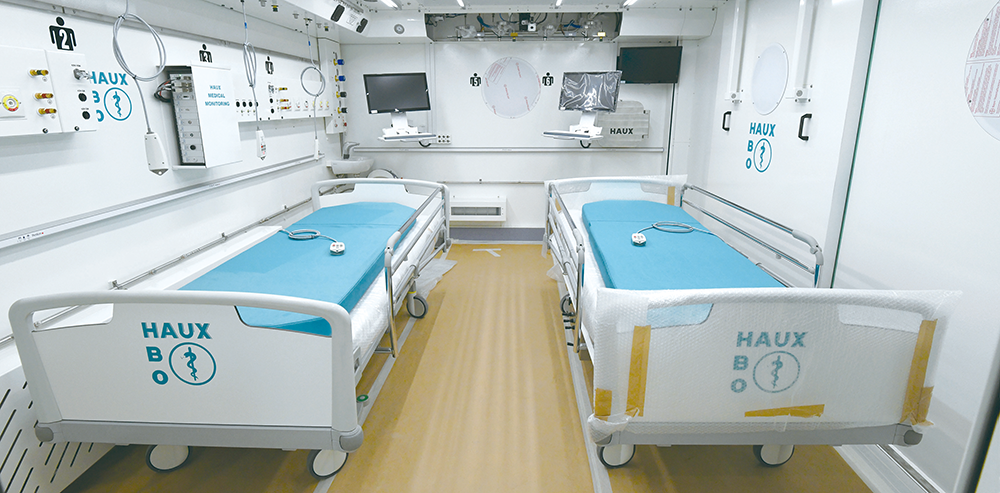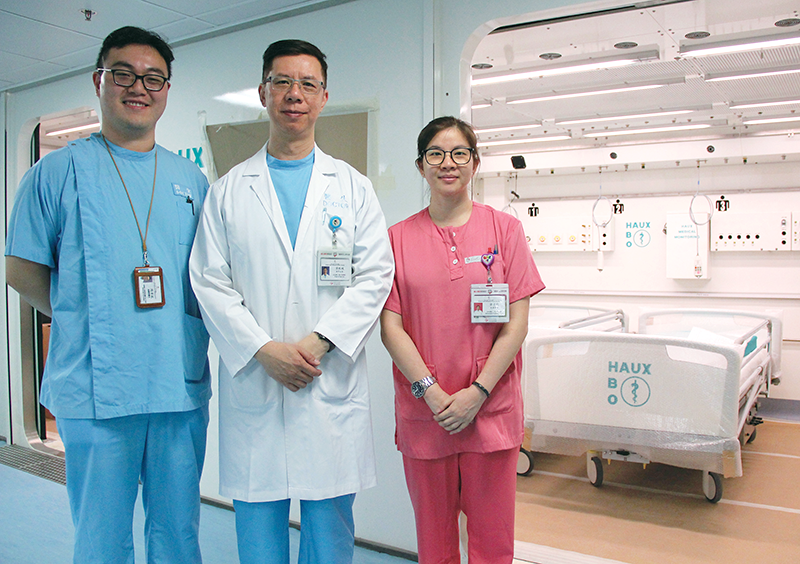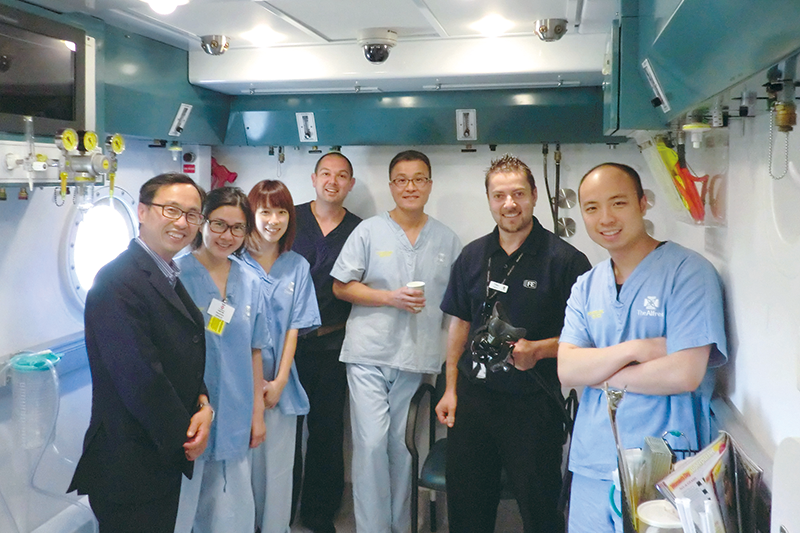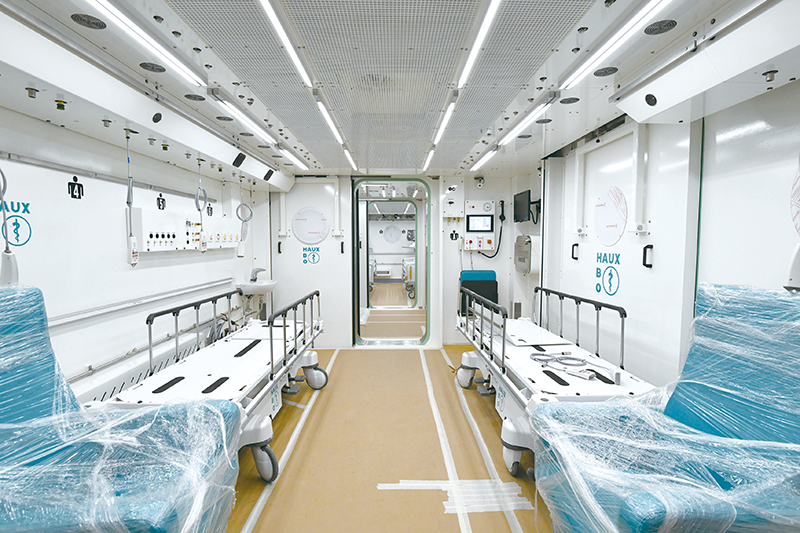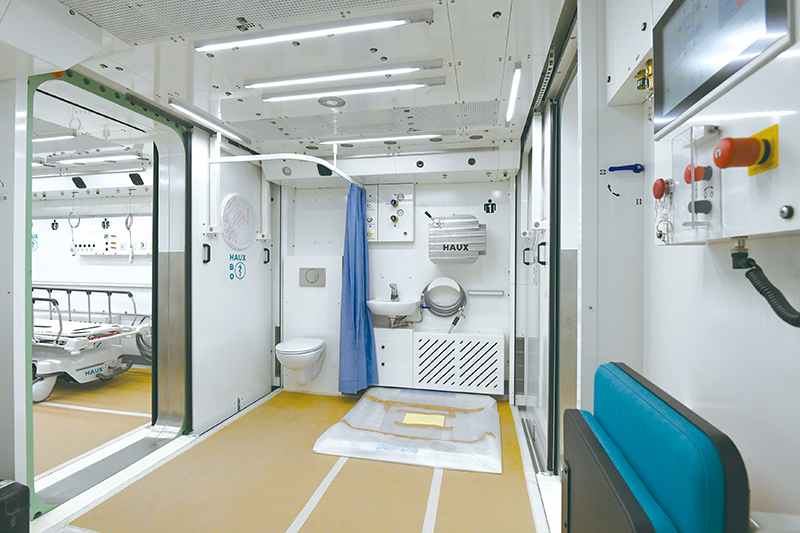33 overseas-trained staff all set for HK’s first HBOT centre in hospital
Hong Kong’s first hyperbaric oxygen therapy (HBOT) centre located in Pamela Youde Nethersole Eastern Hospital (PYNEH) will start operation in late September this year, serving patients with life threatening diseases. The centre will be in full service in November. Dr Joe Leung, Chief of Service of Accident and Emergency (A&E) Department of PYNEH, reckons that the inconvenient location of the existing centre run by Fire Services Department on Stonecutters Island makes patient transfer risky. Besides, receiving treatment at a centre in hospital will facilitate recovery of patients.
The HBOT chamber is now under installation and the service details are being mapped out. The HBOT chamber is the first of its kind for medical use in Hong Kong and no local training is available. Seven doctors and 26 nurses from A&E Department of PYNEH underwent training in countries including the USA, Australia and Singapore and are now qualified for delivering the therapy. Doctor’s training focuses on assessment of patients on eligibility in receiving HBOT and tests before and after treatment. Nurses learn more about patient care, safety, emergency handling inside chamber as well as patient education.
Dr Leung expresses, “Every country has its strengths. The USA values more safety management of treatment while Australia is skilful in patient communication and psychological care. Apart from training, we participated in many conferences to gain up‑to‑date knowledge in international standard and centre operation. In a conference I joined earlier in the USA, I learnt that three consecutive sessions of HBOT treatment are more effective than the traditional practice of one daily treatment for three days for carbon monoxide poisoning cases. This will affect our manpower arrangement.”
Dr Jeffrey Chau, Associate Consultant of A&E Department, says, “Drills of various kinds of incidents, for example, patient fainting in chamber and equipment failure, are done regularly. We also conduct drills with Fire Services Department to ensure safety.” Teresa Leung, Advance Practice Nurse of A&E Department adds, “Flammable objects, like mobile phones, lighters and cosmetics, are banned because the chamber is filled with concentrated oxygen. And to prevent inducing static electricity, patients and staff are required to dress in pure cotton.”
HBOT treats 13 illnesses
Currently, patients of 13 types of diseases are eligible for HBOT treatment, including emergency cases like carbon monoxide poisoning and decompression illness, as well as elective cases like diabetes and delayed radiation injuries. However, of these cases, patients who suffer from pneumothorax, take certain chemotherapeutic drugs, or have a hollow prosthesis in body, such as ocular prosthesis, are not suitable for the treatment. 20 to 30 sessions are needed for elective cases with each lasts for two to three hours while several sessions are required for emergency cases. In the initial stage of service, one session will be provided every day and the number will be adjusted according to demand and manpower allocation.
During the treatment, while a doctor or nurse is taking care of patients inside the chamber, one to two medical staff will coordinate outside with support of a technician. A staff member can only work in the chamber once every 24 hours because it takes time for them to emit extra nitrogen in the body after staying in an environment with a high concentration of nitrogen of two to three times to normal level. Otherwise, after returning to normal air pressure, air bubbles may form and block blood vessels. Attending doctors of specialty from other public hospitals can refer suitable patients to PYNEH by coordinating with the corresponding specialty of PYNEH, and then discuss the case together with the HBOT team. Finally, a doctor from the team will assess the referred patient to determine whether he is suitable for HBOT treatment and then arrange booking for treatment.
Profile of HBOT chamber
Weight: about 100 tonnes
Dimension: 13 metres x 3.8 metres x 2.8 metres
Capacity: 16 patients at most
Origin: Germany
Click here for the video to know more about the installation process and features of the chamber.
● "Patient always on my mind during typhoons!"
COVER STORY
● Birth of CNS: Woman living in a bathtub
● Holistic care passed on in community through generations
FEATURE
● Volunteer experience sheds light on career direction
● Small changes in ward improve patient care
HELEN HA
● Check out the fun facts about HA
● Blood donation, finding way and shopping made easy with apps
WHAT'S NEW
● New blood of HA Board vows to speak up for colleagues
● 2018/19 Funding and budget allocation at a glance
● 33 overseas-trained staff all set for HK’s first HBOT centre in hospital
STAFF CORNER
● 30 awardees on 2018 Honours List
● 延續的生命 (Chinese version only)

